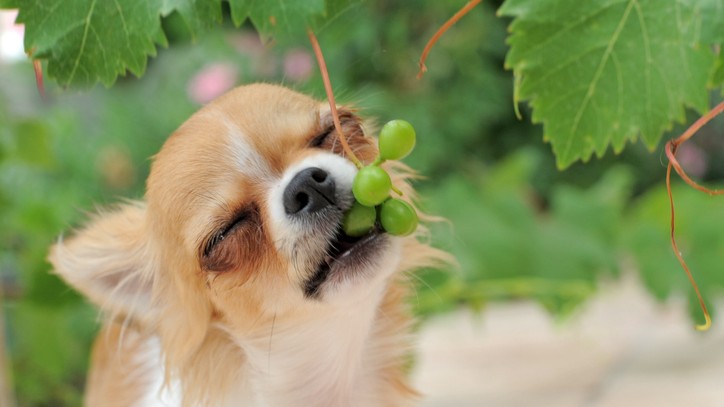Can dogs eat grapes? Veterinary nurse reveals everything you need to know
Can dogs eat grapes? Get expert advice on the potential risks, symptoms of grape toxicity, and what to do if your pup eats them

Grapes are often hailed as a perfect snack for humans; sweet yet healthy and a perfect size but can dogs eat grapes?
Grapes, and the popular discussion surrounding whether they are safe for dogs to eat not only includes all the color varieties of the grape family such as white, red and black but also all its dried forms too… raisins, currents and sultanas.
It’s tempting to offer your begging dog an odd one or two from your bunch of grapes while you both watch your favorite TV show or maybe they get their nose into the fruit bowl or they snatch an opportunity outside when they notice rogue grape on the sidewalk.
In any case, is it safe and healthy for your dog to eat grapes? Are these good treats to offer dogs or are there better options like best dog treats for example?
After spending over twenty years in the veterinary profession and experiencing first hand the effects of dogs consuming grapes, it's a topic and information pet parents need to be aware of, especially because of the abundance grapes are found in in our modern times, so let’s find out the answer for certain.

Annaliese qualified as a veterinary nurse from Edinburgh and went on to attain a diploma in advanced veterinary nursing in surgery from London. Annaliese worked in both small and mixed veterinary practices and gained head nurse status. She has looked after 1,000s of patients and co-authored multiple books.
Are grapes bad for dogs?
Whilst grapes are abundant in healthy nutrients for people, unfortunately, all colors and forms of grapes are bad for dogs. They are highly toxic causing severe health complications capable of fatality in some cases.
Certain dogs can suffer a more complicated reaction whereby any number of raisins eaten causes toxicity. Others suffer little or no reaction at all to the grape family. The field, though, is wide open for problems as breed, sex and age have no influence on the level of toxicity your dog will endure following eating grapes, according to The Kennel Club.
Get the best advice, tips and top tech for your beloved Pets
As to why grapes are toxic, this has long been a mystery and baffled science as to what exactly the substance is in the grapes causing the issue. However, a discovery in 2021 reported by The American Animal Hospital Association now believes it is tartaric acid found in grapes which is the toxic agent.
It is therefore perhaps prudent, given the severity of damage grapes can do, to not keep grapes or any of their formats in the home. However, as this often isn't practical, it's a wise idea to ensure they are kept out of reach of your dog or in a cupboard and not offered as a well meaning treat.
You may wish to consult our guide on what human food can dogs eat if you want to share some of your own snacks that are safe for your canine. Keep in mind though, treats should not make up more than 10% of your dog’s daily diet and calorie requirements as outlined by the experts at UC Davis Veterinary Medicine. Furthermore, if your dog is on a weight reduction program or on a prescription diet, treats shouldn’t be offered at all unless your veterinarian advises otherwise.
What happens when a dog eats a grape?
There are plenty of fruits dogs can enjoy. Can dogs eat oranges? This is a common question asked as well, for example, due to oranges being a lush and healthy fruit. But when a dog eats a grape, in any form or amount, the risk of them being poisoned is likely.
According to the MSD Veterinary Manual an exact figure of the required amount of grapes needed to be ingested by a dog to cause toxicity remains unclear, in the past, as few as four to five grapes eaten by an 8.2 kg dog were enough to cause poisoning. This demonstrates that even eating only a few grapes is problematic.
After ingestion, the toxic portion of grapes will begin to make your dog sick and they will start to exhibit signs as listed below within twelve hours. Sometimes as early as six hours. If left untreated, or not treated promptly, the kidneys become severely affected within one-three days and will begin to fail. It is the failing kidneys posing the biggest threat of death for your dog following eating grapes.

Signs of grape toxicity in dogs
Signs of grape toxicity will vary from case to case, and they may well develop at different paces depending on your dog but in general, the following signs are seen initially before kidney failure commences.
These usually begin within 12 hours and include but are not limited to:
- Nausea (seen as hypersalivation, licking lips and/or pacing about)
- Vomiting
- Lethargy
- Abdominal discomfort and/or pain
- Decreased appetite or not eating at all
- Increased drinking (thirst)
- Increased urination
- Dehydration
- Shivering (tremors)
Within one to three days of eating the grapes, severe kidney failure develops, particularly if early treatment is not sought. Sadly, if your dog has reached this stage the likelihood of recovery is exceptionally slim, and they will either die naturally or be euthanized as it is untreatable.
What to do if your dog eats a grape
If your dog has eaten grapes or any of its dried forms even a single one, or you suspect they may have, then immediate emergency treatment must be sought. Contact your veterinarian straight away who will be able to advise on the next steps. Should this incident occur outside of your veterinarian’s regular opening hours you must call their emergency number or out-of-hours service.
It is vital advice and treatment begin as soon as you are aware of the problem to prevent your dog from deteriorating. After your vet has made the diagnosis they will endeavor to block the toxins from being absorbed into the body and minimize the damage to the kidneys as best they can.
If you want ideas for alternative healthy treats check out our list of eight surprising vegetables that are completely safe for your dog to eat.
Annaliese qualified as a veterinary nurse from Edinburgh and went on to attain a diploma in advanced veterinary nursing in surgery from London. Throughout this time, she worked in both small and mixed veterinary practices and gained head nurse status. Responsible for training other veterinary nurses she also ran the nursing department, nurse clinics, and patient care protocols.
She has looked after 1,000s of patients and owners and created new higher standard nursing regimes, whilst specializing in surgery and anesthesia. After being asked to co-author multiple veterinary nursing textbooks, Annaliese continued to write for further mainstream publications in the UK and USA and after twenty-plus years in both the veterinary and pet care professions, she hung up her scrub suit and now writes full-time.
